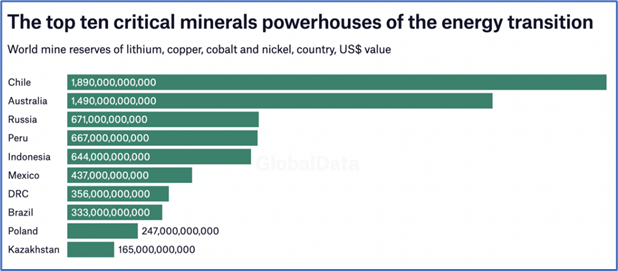What’s in Today’s Article?
- Background (Context of the Article)
- About Critical Minerals (Meaning, Examples, Importance, Reserves, etc.)
- ’s Policy (Steps Taken by Govt., About Domestic Production, etc.)
Background:
- In June, the Ministry of Mines launched the fourth tranche of critical minerals auction, offering 21 blocks across 14 states.
- To incentivize exploration, the ministry announced a scheme to reimburse up to Rs 20 crore in exploration expenses for license holders.
- License holders can claim up to Rs 20 crore for exploration activities and may receive additional reimbursements if they hand over a block for mining lease within three years.
What are Critical Minerals?
- Critical minerals are raw materials essential for economic and national security, often used in high-tech industries and renewable energy technologies.
- They are typically rare, difficult to mine and substitute, and often vulnerable to supply chain disruptions due to limited global production and geopolitical factors.
- The growing demand for these minerals, driven by technological advancements and the global transition to green energy, underscores their critical importance.
- Securing a stable supply of critical minerals is thus a strategic priority for many countries to ensure economic stability and technological progress.
Examples of Critical Minerals:
- Lithium:
- Used in lithium-ion batteries for EVs, consumer electronics, and energy storage systems.
- According to the US Geological Survey (USGS), Australia and Chile boast the largest reserves of lithium available in mines around the world today.
- Cobalt:
- Essential for battery production, aerospace components, and other high-strength alloys.
- The Democratic Republic of Congo (DRC) is by far the largest global supplier of cobalt, possessing almost half of all cobalt reserves in global mines.
- Graphite:
- Key for batteries, fuel cells, and high-temperature applications.
- In 2023, China had the world's largest reserves of natural graphite, at approximately 78 million metric tons.
- Nickel:
- Important for stainless steel production and battery manufacturing.
- Australia and Indonesia boast the world’s largest reserves of nickel in global mines today.
- Rare Earth Elements (REEs):
- Vital for manufacturing electronics, magnets, and military applications.
- According to estimates, the total worldwide reserves of rare earths amount to approximately 110 million metric tons.
- Most of these reserves are located within China, estimated at some 44 million metric tons.
- After China, the major rare earth countries based on reserve volume are Vietnam, Russia, and Brazil.
Critical Minerals Reserves in the World & India:

- India does not have reserves of nickel, cobalt, molybdenum, rare earth elements, neodymium and indium, and the country’s requirement of copper and silver are higher than its current reserves.
Significance/Importance of Critical Minerals:
- Minerals such as copper, lithium, nickel, cobalt, REEs are essential for the world’s ongoing efforts to switch to greener and cleaner energy.
- The International Energy Agency has said that the world’s goal to limit global warming to 1.5 degrees Celsius in the net zero emissions scenario, would translate into very rapid growth in demand for these minerals.
- By 2040, the demand for copper is expected to rise 50%, double for nickel, cobalt and rare earth elements, quadruple for graphite and eightfold for lithium, which is crucial for batteries.
- In India, the lack of ready reserves of critical minerals has resulted in 100% import dependence for minerals like lithium, cobalt, and nickel.
Steps Taken by Govt. to Explore These Minerals:
- Recognizing the risks of relying on a few countries for mineral supplies, the Indian government amended the Mines and Minerals (Development and Regulation) Act, 1957, to allow mining concessions for 24 critical minerals.
- This led to the launch of auctions for 20 mineral blocks, including the lithium block in J&K.
- However, initial investor interest was low, resulting in the cancellation of most auctions due to a lack of bidders.
- The first successful auctions resulted in six winners for blocks in Odisha, Tamil Nadu, Uttar Pradesh, and Chhattisgarh.
- The results of subsequent auction rounds are still pending, and a fourth tranche, including 10 re-offered blocks, has been initiated.
Why are some Blocks not Finding Takers?
- As per industry experts, the reasons for low interest among miners for some of these blocks include the lack of adequate data on the potential reserves buried within them.
- Technology challenges also affect outcomes. For instance, the lithium block in J&K has clay deposits, and the technology for the mineral’s extraction from clay remains untested globally.
When is Domestic Production likely to Begin?
- The commercialization of India's domestic mineral blocks is still in early exploration stages and is unlikely to yield significant benefits by 2030, according to ICRA.
- To mitigate this risk, the Indian government is encouraging exploration and attracting more miners.
- Additionally, India is acquiring overseas mineral assets, such as a lithium brine mine in Argentina, through a joint venture called Khanij Bidesh India Limited.
- India has also joined the U.S.-led Mineral Security Partnership, which includes major buyers and sellers of critical minerals, to further secure its mineral supply.









